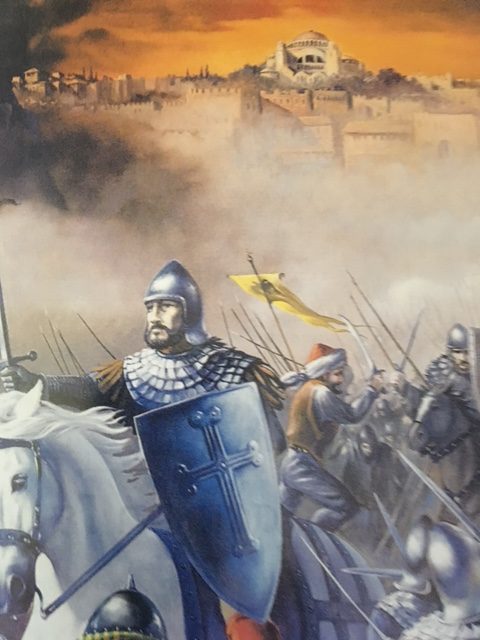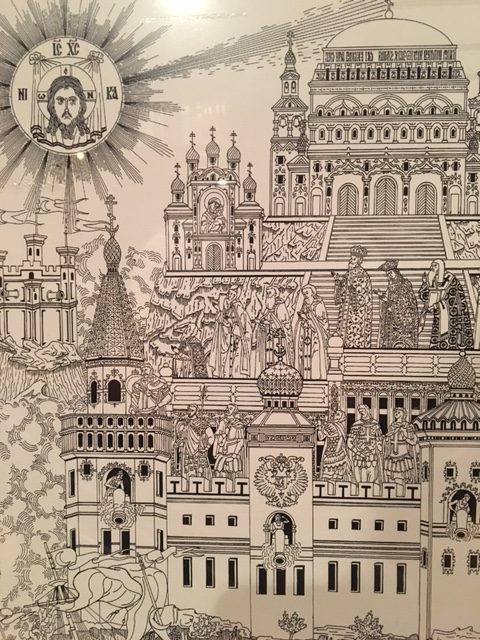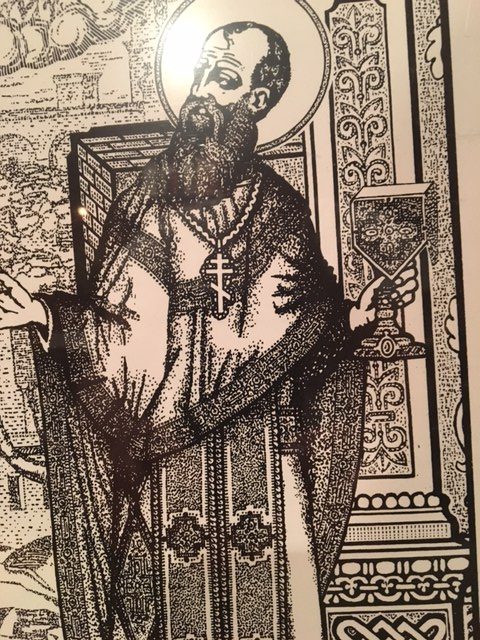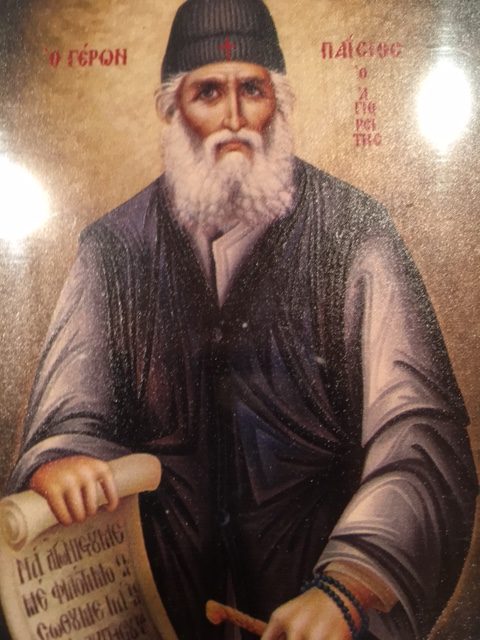Like any Greek, I consider Constantinople the center of Hellenism and the Orthodox world. I know the Greek folk songs that celebrate the establishment of the City by Constantine and the songs and myths that lament the passing of the City to the infidel Ottomans on 29 May 1453. The spiritual and cultural heritage of Constantinople is tremendous. At a time when the western world was in the dark ages, the Queen of the Cities ruled the world and was the envy of all.
Tragically, the Ecumenical Patriarchate and much of the Greek world has in the past year and a half betrayed the spiritual legacy of Constantinople. The Ecumenical Patriarchate reversed after twenty six years a principled policy of respecting the canon laws of the Church and bestowed recognition on a group of narcissistic lunatics as “Bishops” while withdrawing recognition from the legitimate Ukrainian Orthodox Church under the synod of the immensely pious and well loved Metropolitan Onuphry.
The Ukrainian Orthodox Church which enjoys an autonomous or self governing status under the Russian Orthodox Church (the Mother Church of Ukraine) is recognized by the overwhelming majority of local Orthodox Churches as the canonical Orthodox Church. This recognition was unanimous and without exception until his all holiness Patriarch Bartholomew without explanation in September 2018 began the process of waging war against the Russian Church.
In December 2018, a pseudo council (a fake gathering that is a mockery of the conciliar tradition of Orthodoxy) was gathered which created the so called “Orthodox Church of Ukraine” led by a layman named Dimenko who claims the ecclesiastical name of “Epiphanios”. Mr. Dimenko and his associates who claim to be Bishops and priests are no such thing. In January 2019, a fictitious “tomos” of “autocephaly” was granted to these schismatics by the Ecumenical Patriarchate.
In the early period of the 1990’s, two schisms took place in the Ukrainian Orthodox Church. A megalomaniac who was once the canonical and legitimate Metropolitan of Kiev (Philaret Denisenko) was removed and later anathematized owing to his schismatic activities as a result of his failed candidacy to become Patriarch of Moscow in 1990. Furthermore, there was another schism involving yet another faction from the legitimate Church led by a deacon who was laicized as a result of moral and criminal transgressions.
This particular “Deacon” apparently ordained himself to the priesthood and also apparently consecrated himself a Bishop completely mocking the Holy Canons of the Orthodox Church. This was the situation regarding ecclesiastical affairs of Ukraine on the eve of the Ecumenical Patriarchate’s unwanted interference.
The situation is even more complicated by the presence and the activities of the Uniates, so called “Eastern Catholics”. This particular group has its origins in the Council of Florence of 1439 and the Union of Brest of 1595. When Ukrainian lands were conquered by the Catholic powers at the time, the long discredited and condemned Council of Florence that the Greeks had repudiated was brought back. The Orthodox populations in the conquered lands were permitted to maintain the Byzantine liturgical service but were forced to accept the authority of the Roman Catholic Pope and the dogmas of Catholicism such as the teaching on the filioque.
The Ukrainian Orthodox Church was under the omophorion of Constantinople from 988 AD until 1686 when the Ecumenical Patriarch Dyonisius V agreed to transfer the Ukrainian Church to the Russian Church. There are documents that attest to the legitimacy of this transfer.
After over three centuries Constantinople suddenly announced that Ukraine is part of its own omophorion. This was a blatant violation of canon law and an attack on Orthodox ecclesiology. One hierarch of the Ecumenical Patriarchate had previously promoted a never before heard of theory that the Ecumenical Patriarchate is “First Without Equals”, a claim that provoked concerns and widespread opposition throughout Orthodoxy.
The truth is that the Ecumenical Patriarch holds a position as “First Among Equals”. He is the first ranking Orthodox primate in the dyptychs of the Church and is (or was) commemorated first by all his fellow primates and given the seat of honor at all Pan Orthodox convocations. Likewise, when concelebrating the liturgy with other primates either individually or collectively he was always given precedence in honor.
The Ukrainian Church situation was problematic not only because of the schisms and the activities of the Uniates (an organization existing to destroy Russian Orthodoxy) but because the Ukrainian government under President Poroshenko permitted, if not outright promoted the fierce persecution of the Ukrainian Orthodox Church. This persecution continues to the present day. Efforts have been made by Ukrainian officials to force the Ukrainian Orthodox Church (the canonical one) into changing its name to “Russian Orthodox Church in Ukraine”.
There have been violent activities by militias (with Neo Nazi sympathies) directed at the Ukrainian Church including the forcible seizure of Churches and violent assaults on clergy and laity alike. It is in this backdrop that the Ecumenical Patriarchate sent two exarchs to Ukraine in September 2018 with the intention of bestowing “autocephaly” on the schismatics who have shown no tendency toward repenting and reconciling with the canonical Church.
Despite holding a “primacy of honor”, the Ecumenical Patriarchate has absolutely no right or authority to bestow “autocephaly” on a Church that is not directly under its own omophorion. It is forbidden under canon law for one Church to intervene without permission or invitation into the affairs of another autocephalous or self governing Church. The December 2018 pseudo-council was intended supposedly to “reunite” Orthodoxy in Ukraine. The canonical Church did not take part because being in the line of apostolic succession, it could not sit down with laymen who masquerade as Bishops.
Furthermore, the aforementioned and notorious Philaret Denisenko who led his faction into schism after failing to be elected Patriarch of Moscow in 1990 created a schism from this “united” group after being sidelined in favor of the younger layperson Mr. Dimenko. The schismatic groups are nothing more than power hungry narcissists dressing as Bishops. Involving himself with such people is going to have devastating repercussions for Patriarch Barholomew and the Ecumenical Patriarchate.
The Russian Church and its hierarchy, together with its priests, theologians, and canonists responded calmly citing the holy canons, dogmas, and teachings of the Church on this situation. They have properly exposed Constantinople’s blatant violations of canon law and the destabilization of universal Orthodoxy. It is indicative that Constantinople has generally refrained from responding point by point to the to case put forward by the Russian Church which has armed itself with historical documents as well as ecclesiastical texts.
Some of Constantinople’s supporters have responded in irrational ways and seem to have no idea that the Orthodox Church functions in a conciliar manner and not under the ecclesiastical dictatorship of one Bishop. Conciliarity means all Churches are equal (except in honor) and all decisions are made under the auspices of the Holy Spirit by consensus of all.
The Russian Church responded (rightly) by severing communion with Constantinople. It should be remembered that Patriarch Kyril of Moscow originally suggested that committees should be established by both sides to study the history of the Church of Ukraine. The consciousness of wrongdoing by Constantinople can be proven by its outright refusal to engage in any discussions. Only as a last resort did Moscow sever communion with Constantinople, and then only in phases.
The damage to Orthodox unity was not contained in Ukraine. The Orthodox Church of Greece was dragged into the matter by the Phanariots of Constantinople. After nearly a year of postponement by the Holy Synod in discussing the matter, the Athens synod finally capitulated in a shocking and heartbreaking decision as a result of western pressure.
It is known that the secular powers have intervened blatantly in the affairs of the Orthodox Church. American officials have undertaken a public attack on Russia internationally. This rabid Russophobia has extended into the Orthodox Church proving that the godless elite of the secular west has no respect of any kind for the sacred. The Church is for them nothing more than an institution to be infiltrated and influenced for their own purposes.
It is known that Secretary of State Mike Pompeo visited Athens and personally asked Archbishop Ieronymos of Athens to recognize the schismatic entity in Ukraine. Previous to this visit in August 2019, the Synod of the Church of Greece had announced that they would not discuss the Ukrainian issue at their scheduled meeting in October. Following Pompeo’s arrival, an emergency session was held by the Holy Synod and recognition of the schismatics ensued.
The capitulation of the Church of Greece to the dictates of American policymakers is a moral outrage and a betrayal of Christ and the Holy Canons of the Church. Some Bishops including Metropolitans Serapheim of Kythira, Serapheim of Piraeus, Nektarios of Corfu, and Simeon of New Smyrna, and now retired Ambrosios of Kalavryta refused to go along.
AXIOS to each of them!
There are individual priests and theologians such as Fr. Anastasios Gotsopoulos, Fr.Theodore Zisis, and Professor Demetrios Tselengidis who have opposed recognition of the schismatics with well thought out and detailed arguments based on historical facts and canonical precepts. Before the final and fateful decision of the Holy Synod, a petition in Greece signed by several hundred priests, monastics, and laypeople fervently appealed to the synod NOT to recognize the schismatics.
The so called “Orthodox Church of Ukraine” is not and cannot be legitimate as it lacks apostolicity, canonicity, and catholicity. The Orthodox Bishops can trace their lineage back to the Apostles. The schismatics in Ukraine only go back three decades or so to the defrocked and disgraced founders of their “Church”. All subsequent ordinations (priests) and consecrations (Bishops) are completely void of any canonical legitimacy. The term Catholic meaning universal deprives them of “catholicity” as the universal Church refuses to accept them and views them as an abomination.
After the Orthodox Church of Greece, the Greek Orthodox Patriarchate of Alexandria surrendered and recognized the schismatics. His beautitude Patriarch Theodore II of Alexandria had one year previously gone to Odessa and concelebrated with the canonical clergy and faithful of Ukraine. He strongly urged the faithful of Ukraine to stay with the legitimate Church of Ukraine. One year later, he betrayed the Ukrainian Church.
The Church of Cyprus has not recognized the schismatics. Efforts have been made to pressure the Greek Orthodox Patriarch of Jerusalem into recognizing the schismatics. To his credit, his Beautitude Patriarch Theophilos III has absolutely refused to succumb to pressure and recognizes only the legitimate Church of Ukraine. In a show of leadership, Patriarch Theophilos convened a gathering of Orthodox Churches (only around six or seven attended) to discuss the crisis in Orthodoxy. No decisions were made and the gathering could not be considered as a real council but in the vacuum left by Constantinople, Jerusalem attempted to fill that void for which its Patriarch has been widely condemned by the Phanariots.
The capitulation of three Greek Churches is shameful not only because of the surrender of the Church to secular interests. It is a repetition of previous historical injustices against the Greeks. In 1204, the Roman Catholic Crusaders invaded and destroyed Constantinople. In 1439, the Roman Catholics blackmailed the Greeks at the Council of Florence and demanded that they accept Roman Catholic dogmas and the primacy of the Pope at the expense of the faith received from the Apostles and the Fathers.
After the completion of the Greek War of Independence the British and the Germans took defacto control of Greece. They imposed the German King Otho on Athens. Otho and his advisors immediately demanded the “autocephaly” of the Church of Greece from the Ecumenical Patriarchate. Ironies abound, Constantinople is doing to Moscow today on behalf of Washington what London did to Constantinople two centuries ago.
The autocephaly Greece originally got was an artificial one in which the Church was composed of a small synod controlled by the King. The purpose of this “autocephaly” was not to keep Turkish influence out of Greece as was claimed but to keep Russian influence out of Greece as Russia was then financially and politically supporting the Ecumenical Patriarchate. In addition, seventy two Churches in Athens from the Byzantine era were destroyed in order to build the Cathedral! The septuagaint version of the Old Testament was prohibited in favor of the Protestant one, Byzantine domes were banned as Churches were built in a Protestant style, and Byzantine style iconography was replaced by western religious art.
Furthermore, General Theodore Kolokotronis the hero of the Greek War of Independence was imprisoned and initially sentenced to death for “treason”. The old General was the leader of the Russian Party in Greece and was also angered by the Monarchy’s Church policies. Only the threat of a mass uprising led to the pardon of the General.
I have long believed that a Greek-Russian rivalry was nonexistent. Admittedly, it is extremely difficult to defend this position at a time when three Greek Churches have collaborated in the dismemberment of the Russian Church in Ukraine. However, these actions are motivated by blatant western political interference and do not reflect the views of their faithful.
I as a Greek American adhere to the old Constantinople-Greek school of faith that produced Constantine, Justinian, and the other Orthodox Emperors. The Constantinople that produced Saint Gregory the theologian, John Chrysostom, Photius the Great, Michael Kerularios, George “Gennadios”Scholarios, Jeremias II, Cyril V, and Saint Gregory V and other Orthodox Patriarchs.
Constantinople’s spiritual legacy is immense and undeniable. Its legacy has been betrayed by the present leadership of the Phanar and those other Greeks collaborating with it. There is no shortage of ironies in terms of what has been done in Ukraine. The Ecumenical Patriarchate has the open backing in Ukraine not only of Secretary of State Mike Pompeo, but of former Vice President and Presidential Candidate Joe Biden and American Ambassador to Greece Geoffrey Pyatt.
Why is the Ecumenical Patriarchate in a precarious state in Turkey today? Why has it lost most of its flock? The Greek Orthodox of Asia minor were exterminated in a campaign of genocide by the Turks between 1914 and 1923. At the Treaty of Lausanne, the Great Powers of Great Britain, France, and Italy pressured the Turks to maintain the Ecumenical Patriarchate even though they agreed to deport over one million faithful to Greece in a campaign of ethnic cleansing and took away the diplomatic protection the Phanar previously had.
In September 1955, came the anti Greek pogroms in Constantinople in which the remaining Greek Orthodox in the City fled for their lives. Neither the United States nor NATO did anything to support the Ecumenical Patriarchate or to punish the Turkish Government which sponsored the pogroms. In 1964 and after, more Greeks were ethnically cleansed from Constantinople with no opposition from the West, and in 1971 the theological school of Halki was closed.
The Ecumenical Patriarchate today having been fiercely persecuted by the Turks actively supports the persecution of the Ukrainian Orthodox Church. The Ecumenical Patriarchate is supported here by State Department officials whose predecessors were oblivious to the ethnic cleansing of the Phanar’s own flock in 1955 and after. This is obscene on so many levels.
I happen to love Constantinople and the Ecumenical Patriarchate also. This is why as a Greek Orthodox I must speak and condemn what the Ecumenical Patriarchate has done in Ukraine. Because Christ is the true head of the Church, the Church is conciliar and is governed by the canons, and the great spiritual legacy of Constantinople is being reduced to total ruin.
In 1853, Russia went to war with the Ottoman Empire. Great Britain and France backed the Ottomans. What Greek would not have rejoiced had the Russians liberated Constantinople? Greece at the time wanted to join the Russians but the port of Piraeus was occupied by Great Britain and France who showed the Greeks their place much as Washington today shows the Greeks who is boss.
In 1915, the Government under Tsar Nicholas II persuaded Great Britain and France to give Constantinople to Russia in a secret agreement. What Greek would not have rejoiced in Russia liberating Constantinople? For centuries, the Russians served to restrain the Ottomans in their persecution of Greeks and other Christians.
Catherine the Great envisioned a Greek project with an independent Greece with its capital at Constantinople. Russia is the carrier of Eastern Orthodoxy and in my opinion, the Third Rome. For historic and political reasons, but most importantly for spiritual, dogmatic, and canonical reasons there is no justification whatsoever for the Church of Constantinople to be meddling in Ukraine.
Finally, it is true that Russia received baptism from Constantinople. The ties between the two Churches would be much stronger if the Ecumenical Patriarchate acknowledged the Russian Church as the largest among the local Orthodox Churches. What could be more natural than the Archbishop of New Rome showing proper appreciation for the role of Moscow as the Third Rome. In Russia, the spiritual legacy of Constantinople lives on.
The Russian Church has never questioned Constantinople’s position as “First among equals” and the Russian Church has respected the initiatives that the Ecumenical Patriarchate has taken over the last several decades in convening Pan Orthodox gatherings. The “Council” of Crete was an exception owing to the fact that three local Churches (Antioch, Bulgaria, Georgia) had announced that they would not be attending. Without the presence of all Churches, there could be no Council.
The future of the Ecumenical Patriarchate has become more bleak since Patriarch Bartholomew invaded the canonical territory of Moscow. Those of us who love the Great Church are obligated to raise our voices to protest. We must consider the example of Saint Mark of Ephesus.
Saint Mark of Ephesus made it very clear that there could be no possibility or benefits if survival in the world came at the expense of the authentic teaching of the true faith of Christ. We Greeks must make clear we can not follow the Ecumenical Patriarch down the road that he is leading us.
The suffering faithful of the Ukrainian Orthodox Church are our brothers. The Ecumenical Patriarchate must repent and completely reverse all the actions and decisions that it has taken in Ukraine. After the Fall of Constantinople, in January 1454 the Patriarchate was reorganized and the new Patriarch was George Scholarios who took the name of Gennadios.
Patriarch Gennadios had been the disciple of Saint Mark of Ephesus, a champion of Orthodoxy. In those very difficult and horrible days after the Ottoman conquest, the Patriarch did all he could to help his flock survive by striking the best possible deal he could with Sultan Mehmet. The enthronement of Patriarch Gennadios constituted a much needed era of renewal in the history of the Church of Constantinople that had been badly needed after the sorry events that transpired in Florence. Such an era of renewal could occur once again if the Ecumenical Patriarchate abandoned its extraterritorial claims on Ukraine and elsewhere and respected the tradition of conciliarity.
The survival of the Ecumenical Patriarchate depends on its fidelity to Orthodoxy, to the faith of Saint Gregory the Theologian, Saint John Chrysostom, and Saint Photios the Great. Its future and fate depends on its standing within the communion of Orthodox Churches and not its standing at the State Department.
The Ecumenical Patriarchate’s position has fallen very low within Orthodoxy as a result of its actions in Ukraine. These actions must be corrected and a policy of reconciliation and repentance must be pursued with its sister Church of Russia and the latter’s daughter Church in Ukraine.
Greeks do not forget the role that the western powers played in greatly harming the Ecumenical Patriarchate and its flock in the aftermath of the anti Greek Orthodox pogroms in Constantinople in September 1955. Support from these parties will not save the Ecumenical Patriarchate just as the effort to gain the help of Rome at Florence did not save Constantinople. Only Christ who is head of the Orthodox Church can save any and all of the local Churches of Orthodoxy in times of persecution.
Written during the time of the coronavirus an insidious disease which has killed innocent people throughout the world. Let us remember all in our prayers, especially those who died alone and those who endure funerals without family and friends because of the disease.
The Orthodox Church needs unity at this time of crisis and to give assurances to a fallen and troubled world that the light of Jesus Christ and the message of salvation burns bright.
Christos Anesti! Christ is Risen!
The Double Headed Eagle Blog
11 May 2020






